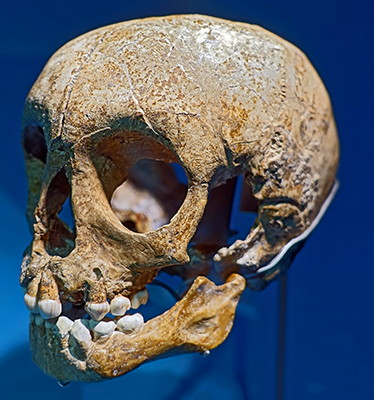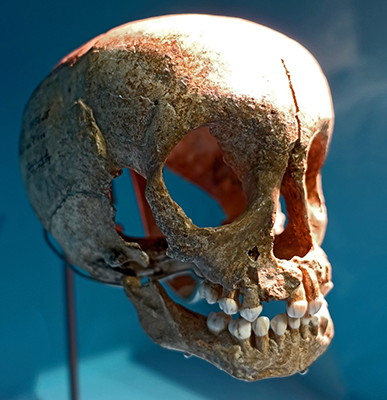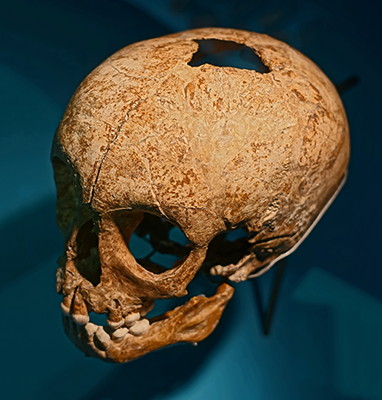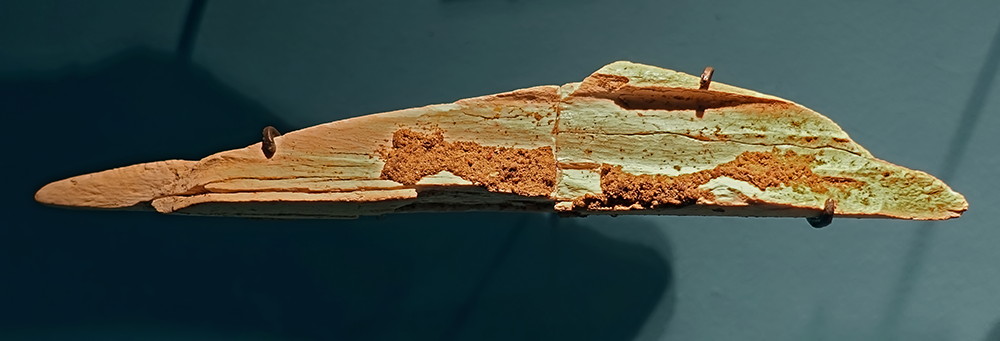Back to Don's Maps
 Mousterian (Neanderthal) Sites
Mousterian (Neanderthal) Sites Back to the review of hominins
Back to the review of hominins
Pech-de-l'Azé
The Pech-de-l'Azé I skull and mandible are included in the juvenile Neandertal remains from Europe. However, some preserved features in the cranial skeleton seem to distinguish the specimen from other Neandertal children. Unfortunately, the stratigraphic position and dating of this child has never been clear. Our recent work on unpublished archives show that the Pech-de-l'Azé I Neandertal child was discovered at the bottom of layer 6, attributed to the Mousterian of Acheulean tradition type B.Text above adapted from: Soressi et al. (2007)
This skull and mandible are the first diagnostic human remains (aside from an isolated tooth) attributed to the Mousterian of Acheulian tradition (MTA) type B. Consequently, we confirm that Neandertals were the makers of this Mousterian industry, which is characterised by unusually high frequencies of Upper Palaeolithic type tools, elongated blanks and blades. We were able to date the context of the hominid remains to about 41.7– 43.6 ka cal BP. A combination of stratigraphic arguments and dating results for layers 6 and 7 show that the Neandertal child cannot be older than 51 ka or younger than 41 ka. This study shows that the MTA type B had been manufactured by Neandertals before the arrival of anatomically modern humans in the local region.
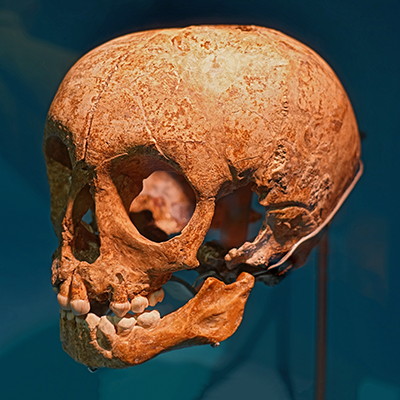
Child skull and mandible from Pech-de-l'Azé, Dordogne.
Original, circa 45 000 BP - 40 000 BP
Photo: Don Hitchcock 2018
Collections du Muséum national d'Histoire naturelle, Paris
Source and text: Musée de l'Homme, Paris
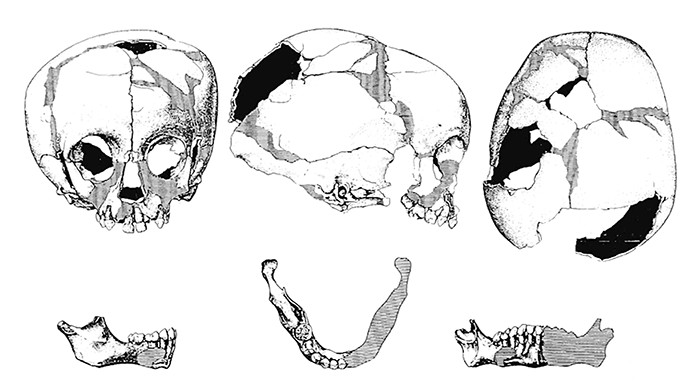
Juvenile human remains, Pech de l'Azé.
Various scales.
Photo: Ferembach et al. (1970)
Proximate source: Bruno et Soressi (2000)
Poinçon, a bone awl for making holes in soft materials such as leather.
Circa 45 000 BP - 40 000 BP
From Pech de l'Azé, Dordogne, France.
Photo: Don Hitchcock 2018
Source and text: Musée de l'Homme, Paris
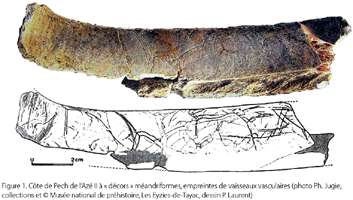
Rib from Pech de l’Azé II with 'macaroni decorations', with the marks of vascular vessels
Photo Ph. Jugie, © collections and Musée national de préhistoire, Les Eyzies-de-Tayac, drawing P. Laurent)
The most famous Neanderthal bone with flowing decorations is this rib fragment discovered by F. Bordes in Pech de l’Azé II, in an Acheulean level. The many serpentine tangled lines present on one side of the rib fragment were interpreted by the discoverer and other authors (Donald, 1991) as a deliberate engraving. This interpretation was confirmed by microscopic analysis carried out by Marshack, who saw in this engraved motif the precursor of the 'macaroni' art (macaroni/meander art is a form of randomly meandering finger flutings) visible on the walls of many decorated caves of the upper Palaeolithic.
(Pech de l’Azé is a cluster of four Lower and Middle Paleolithic sites. They are situated some 50 metres higher than the floor of a small, usually dry, valley that runs into the Enéa, a small tributary of the Dordogne River. Pech de l’Azé I and II are opposite entrances of a single tunnel-like cave that intersects a promontory in the limestone cliff. - http://www.oldstoneage.com/pechiv/pechsites.htm)
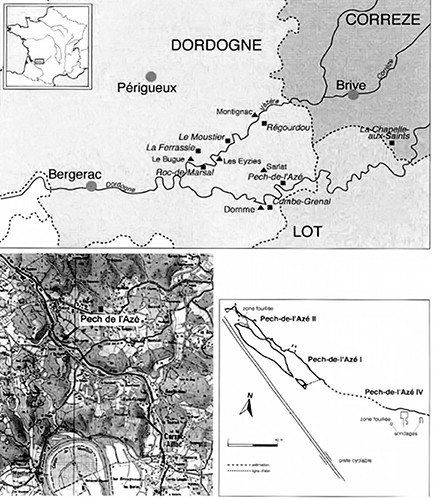
Location of Pech de l'Azé.
Photo: Bruno et Soressi (2000)
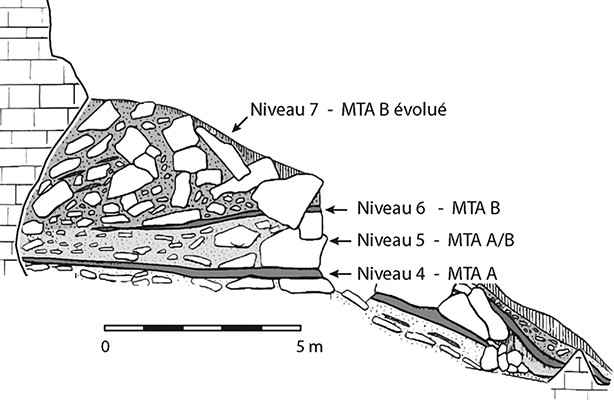
Cross section Pech-de-l'Azé, Dordogne.
Photo: Soressi et al. (2007), after Bordes (1954)
Proximate source: https://www.nespos.org/pages/viewpage.action?pageId=29886225

Evolution of Pech-de-l'Azé, Dordogne.
Photo: Soressi et al. (2006), DAO J.-P. Texier
References
- Bordes F., 1954: Les Gisements du Pech de l’Azé (Dordogne): I, Le Mousterien de tradition Acheulien, L'Anthropologie, 58: 401- 432
- Bruno M., Soressi M., 2000: A propos de la position chronostratigraphique de l'enfant du Pech-de-l'Azé I (commune de Carsac, Dordogne) : la résurrection du fantôme, Paléo, N. 12,2000. pp. 339-352; doi : https://doi.org/10.3406/pal.2000.1606 https://www.persee.fr/doc/pal_1145-3370_2000_num_12_1_1606
- Ferembach D. et al., 1970: L'enfant du Pech-de-l'Azé, Archives de l'Institut de Paléontologie Humaine, mém. 33. Paris: Masson & Cie, p. 1 86.
- Soressi M. et al., 2006: Pech-de-l’Azé I (Dordogne, France) : nouveau regard sur un gisement moustérien de tradition acheuléenne connu depuis le XIXe siècle, Mémoire XLVII de la Société préhistorique française,
- Soressi M. et al., 2007: The Pech-de-l'Azé I Neandertal child: ESR, uranium-series, and AMS 14C dating of its MTA type B context, Journal of Human Evolution, Volume 52, Issue 4, April 2007, Pages 455-466
Back to Don's Maps
 Back to Archaeological Sites
Back to Archaeological Sites
